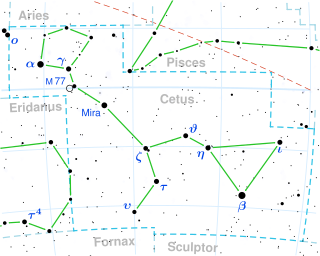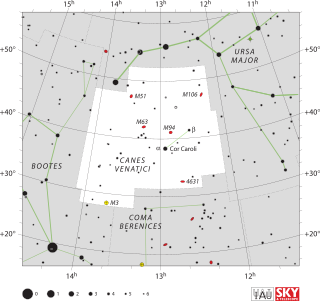
Alpha Herculis, also designated Rasalgethi and 64 Herculis, is a multiple star system in the constellation of Hercules. Appearing as a single point of light to the naked eye, it is resolvable into a number of components through a telescope. It has a combined apparent magnitude of 3.08, although the brightest component is variable in brightness. Based on parallax measurements obtained during the Hipparcos mission, it is approximately 360 light-years (110 parsecs) distant from the Sun. It is also close to another bright star Rasalhague in the vicinity.

Saiph, designation Kappa Orionis and 53 Orionis, is a blue supergiant star and the sixth-brightest star in the constellation of Orion. Of the four bright stars that compose Orion's main quadrangle, it is the star at the south-eastern corner. A northern-hemisphere observer facing south would see it at the lower left of Orion, and a southern-hemisphere observer facing north would see it at the upper right. Parallax measurements yield an estimated distance of 650 light-years from the Sun. It is smaller, less luminous but hotter at its surface than Rigel with an apparent visual magnitude of 2.1. The luminosity of this star changes slightly, varying by 0.04 magnitudes.

Castor is the second-brightest object in the zodiac constellation of Gemini. It has the Bayer designation α Geminorum, which is Latinised to Alpha Geminorum and abbreviated Alpha Gem or α Gem. With an apparent visual magnitude of 1.58, it is one of the brightest stars in the night sky. Castor appears singular to the naked eye, but it is actually a sextuple star system organized into three binary pairs. Although it is the 'α' (alpha) member of the constellation, it is half a magnitude fainter than 'β' (beta) Geminorum, Pollux.

Zeta Puppis, formally named Naos, is the brightest star in the constellation of Puppis.

Alnilam is the central star of Orion's Belt in the equatorial constellation of Orion. It has the Bayer designation ε Orionis, which is Latinised to Epsilon Orionis and abbreviated Epsilon Ori or ε Ori. This is a massive, blue supergiant star some 1,200 light-years distant. It is estimated to be 419,600 times as luminous as the Sun, and 40 times as massive.

Alpha Persei, formally named Mirfak, is the brightest star in the northern constellation of Perseus, outshining the constellation's best-known star, Algol. Alpha Persei has an apparent visual magnitude of 1.8, and is a circumpolar star when viewed from mid-northern latitudes.

Epsilon Pegasi, formally named Enif, is the brightest star in the northern constellation of Pegasus.

Alpha Ceti, officially named Menkar, is the second-brightest star in the constellation of Cetus. It is a cool luminous red giant estimated to be about 250 light years away based on parallax.

Cor Caroli is a binary star designated Alpha Canum Venaticorum or α Canum Venaticorum. The International Astronomical Union uses the name "Cor Caroli" specifically for the brighter star of the binary. Alpha Canum Venaticorum is the brightest point of light in the northern constellation of Canes Venatici.

Alpha Aquarii, officially named Sadalmelik, is a single yellow supergiant star in the constellation of Aquarius. The apparent visual magnitude of 2.94 makes this the second-brightest star in Aquarius. Based upon parallax measurements made by the Gaia spacecraft, it is located at a distance of roughly 690 light-years from the Sun. It is drifting further away from the Sun with a radial velocity of 7.5 km/s.

Beta Aquarii is a single yellow supergiant star in the constellation of Aquarius. It has the official name Sadalsuud and the Bayer designation β Aquarii, abbreviated Beta Aqr or β Aqr. Based upon parallax measurements obtained during the Hipparcos mission, this component is located at a distance of approximately 540 light years (165 parsecs) from the Sun. It is drifting further away with a radial velocity of 6.5 km/s. The star serves as an IAU radial velocity standard.

Alpha Crateris, officially named Alkes, is a star in the constellation of Crater. It is a cool giant star about 43.2 parsecs (141 ly) away.

Mu Sagittarii is a multiple star system in the constellation of Sagittarius. The brightest component, designated Mu Sagittarii Aa, is formally named Polis. The system is 5,000 light-years from the Sun and is part of the Sgr OB1 stellar association.

Sigma Canis Majoris, also named Unurgunite, is a variable star in the southern constellation of Canis Major. It is approximately 1,290 light-years from the Sun and has an average apparent visual magnitude of +3.41.

Alpha Sagittae, formally named Sham, is a single star in the northern constellation of Sagitta. Alpha Sagittae is the Bayer designation, which is latinized from α Sagittae and abbreviated Alpha Sge or α Sge. It is visible to the naked eye as a yellow-hued star with an apparent visual magnitude of +4.38. Despite the name, this is not the brightest star in the constellation – that distinction belongs to Gamma Sagittae. Based upon parallax measurements, Alpha Sagittae is approximately 382 light-years from the Sun. It is moving further away from the Earth with a heliocentric radial velocity of 1.7 km/s.

Beta Leporis, formally named Nihal, is the second brightest star in the constellation of Lepus.

Eta Persei, is a binary star and the 'A' component of a triple star system in the constellation of Perseus. Parallax measurements by the Gaia spacecraft imply that it is 1,000 is light-years away from Earth. At such distance, interstellar dust diminishes its apparent brightness by 0.47 magnitudes.

Alpha2 Capricorni, or Algedi, is a triple star system in the southern constellation of Capricornus. It is visible to the naked eye with an apparent visual magnitude of +3.57. It is separated from the fainter α¹ Capricorni by 0.11° of the sky, a gap just resolvable with the naked eye, similar to Mizar and Alcor. Based on parallax shift as refined from orbits around the Sun of the Gaia spacecraft at Earth's Lagrange point 2, the star is 101 to 103 light years from the Solar System.

HD 74180 is a single star in the constellation Vela. It is a yellow-white F-type supergiant with a mean apparent magnitude of +3.81 and a spectral classification F8Ib. Estimates of its distance to Earth vary between 3,200 and 8,300 light-years.

3 Geminorum is a blue supergiant star in the constellation Gemini. It is a small amplitude pulsating variable and a close double star, with a mean combined apparent visual magnitude of about 5.7.

















